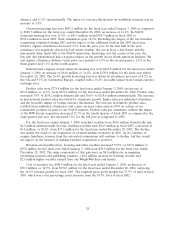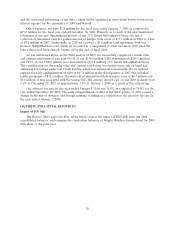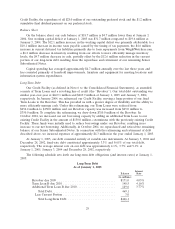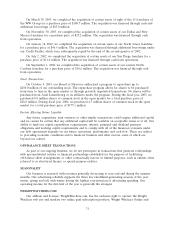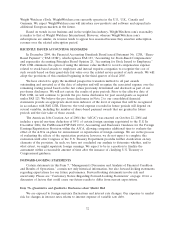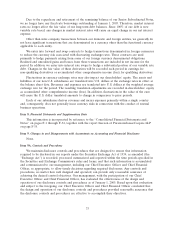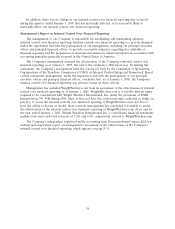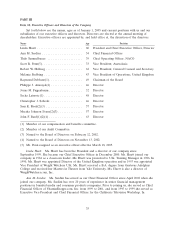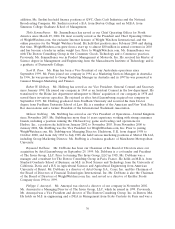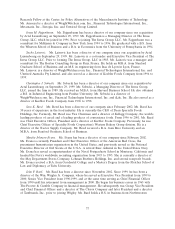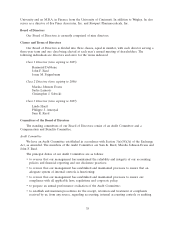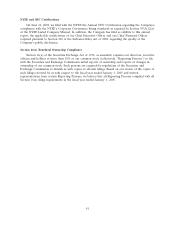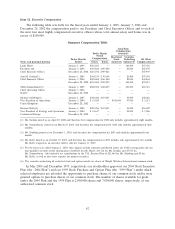WeightWatchers 2004 Annual Report Download - page 40
Download and view the complete annual report
Please find page 40 of the 2004 WeightWatchers annual report below. You can navigate through the pages in the report by either clicking on the pages listed below, or by using the keyword search tool below to find specific information within the annual report.Weight Watchers eTools. WeightWatchers.com currently operates in the U.S., U.K., Canada and
Germany. We expect WeightWatchers.com will introduce new products and software and expand into
additional European markets in the future.
Based on trends in our business and in the weight-loss industry, WeightWatchers.com’s seasonality
is similar to that of Weight Watchers International. However, whereas WeightWatchers.com’s
subscriptions are similar, its revenue tends to appear less seasonal because they amortize subscription
revenue over the related subscription period.
RECENTLY ISSUED ACCOUNTING STANDARDS
In December 2004, the Financial Accounting Standards Board issued Statement No. 123R, ‘‘Share-
Based Payment’’ (‘‘FAS 123R’’), which replaces FAS 123, ‘‘Accounting for Stock-Based Compensation’’
and supercedes Accounting Principles Board Opinion 25, ‘‘Accounting for Stock Issued to Employees.’’
FAS 123R eliminates the option of using the intrinsic value method to record compensation expense
related to stock-based awards to employees and instead requires companies to recognize the cost of
such awards based on their grant-date fair value over the related service period of such awards. We will
adopt the provisions of this standard beginning in the third quarter of fiscal 2005.
We have elected to apply the modified prospective transition method to all past awards
outstanding and unvested as of the date of adoption and will recognize the associated expense over the
remaining vesting period based on the fair values previously determined and disclosed as part of our
pro-forma disclosures. We will not restate the results of prior periods. Prior to the effective date of
FAS 123R, we will continue to provide the pro forma disclosures for past award grants as required
under FAS 123. We believe the pro forma disclosures in Note 2 to our consolidated financial
statements provide an appropriate short-term indicator of the level of expense that will be recognized
in accordance with FAS 123R. However, the total expense recorded in future periods will depend on
several variables, including the number of share-based payment awards that are granted in future
periods and the fair value of those awards.
The American Jobs Creation Act of 2004 (the ‘‘AJCA’’) was enacted on October 22, 2004 and
includes a special one-time deduction of 85% of certain foreign earnings repatriated to the U.S. In
December 2004, the FASB issued FSP FAS 109-2, Accounting and Disclosure Guidance for the Foreign
Earnings Repatriation Provision within the AJCA, allowing companies additional time to evaluate the
effect of the AJCA on plans for reinvestment or repatriation of foreign earnings. We are in the process
of evaluating the effects of the repatriation provision; however, we do not expect to complete this
evaluation until after Congress or the U.S. Treasury Department provides further clarification on key
elements of the provision. As such, we have not concluded our analysis to determine whether, and to
what extent, we might repatriate foreign earnings. We expect to be in a position to finalize the
assessment within a reasonable amount of time after the issuance of clarifying U.S. Treasury or
Congressional guidance.
FORWARD-LOOKING STATEMENTS
Certain statements in this Item 7, ‘‘Management’s Discussion and Analysis of Financial Condition
and Results of Operations,’’ contain not only historical information, but also forward-looking statements
regarding expectations for our future performance. Forward-looking statements involve risk and
uncertainty. Please see ‘‘Cautionary Notice Regarding Forward-Looking Statements’’ on page 10 for a
discussion of factors that could cause our future results to differ from current expectations.
Item 7A. Quantitative and Qualitative Disclosures about Market Risk
We are exposed to foreign currency fluctuations and interest rate changes. Our exposure to market
risk for changes in interest rates relates to interest expense of variable rate debt.
32




